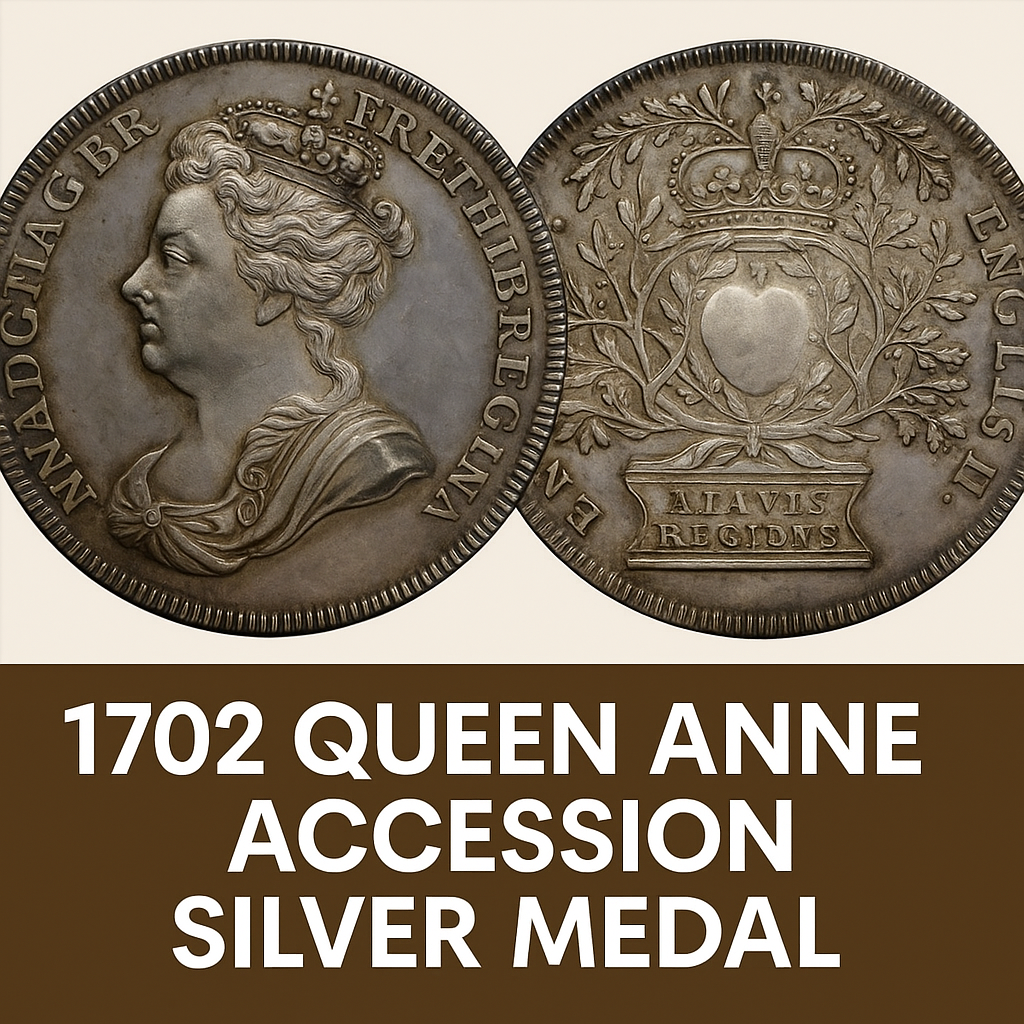The 1702 Queen Anne Accession Silver Medal: A Rare Gem for Collectors and Investors

Introduction: Why This Medal Matters
For collectors and investors, rare coins and medals are more than just metal—they are history you can hold. Among the treasures of British numismatics, the 1702 Queen Anne Accession Silver Medal (Eimer-388) stands out as a fascinating blend of artistry, history, and scarcity. Graded MS61, this piece recently sold at auction for approximately $1,300, underscoring its strong market demand.
But what makes this particular medal so special, and why is it worth a closer look for collectors and investors alike?
Historical Background: A Queen for the English
Anne Stuart ascended the throne in 1702, following the death of William III. Unlike her predecessor—who was Dutch-born—Anne was entirely English, a fact she proudly declared in her first speech to the Accession Council: “I know my heart to be entirely English.”
This proclamation was immortalized on the reverse of her official accession medal. The design features a crowned heart embraced by laurel and oak branches, encircled with the words “ENTIRELY ENGLISH.” It was more than a motto—it was a powerful political message, assuring her subjects of her loyalty to England at a time of uncertainty and foreign wars.
The obverse showcases a regal left-facing bust of Queen Anne, crowned and robed, accompanied by the Latin legend “ANNA D:G: MAG: BR: FR: ET HIB: REGINA” (“Anne, by the grace of God, Queen of Great Britain, France, and Ireland”).
Collectible Details: Specs and Significance
-
Year of Issue: 1702
-
Mint: Royal Mint, London
-
Material: Silver
-
Weight: ~15.8 grams
-
Diameter: ~35 mm
-
Mintage: Approximately 260 pieces (extremely limited)
-
Designer: John Croker (obverse), Samuel Bull (reverse)
With such a low original mintage, surviving specimens are scarce. Among those, MS-graded examples are exceedingly rare, with only about 16 certified by NGC to date. That scarcity alone makes this a highly desirable piece for serious collectors.
Market Performance: Rarity Meets Demand
Queen Anne coins and medals enjoy consistent popularity on the global market. Her reign (1702–1714) produced several iconic issues, including the VIGO silver coins and the first coinage of Great Britain after the Act of Union in 1707.
The accession medal, however, occupies a unique niche: it’s a royal portrait medal with a direct historical message. Auction records show steady demand, with prices for silver examples ranging from $1,200 to over $6,000 depending on condition. Top-tier specimens (MS63 and above) can command significantly higher premiums.
For collectors building a portfolio, this medal represents an ideal balance: historical importance, recognized rarity, and attainable entry cost compared to gold coronation medals or multi-guinea coins.
Why Collectors and Investors Should Pay Attention
-
Scarcity: With only ~260 struck, every surviving piece is a true rarity.
-
Historical Relevance: It embodies a pivotal moment in British history—Anne’s accession and her pledge of loyalty to England.
-
Market Appeal: Demand for British royal medals is international, ensuring liquidity when the time comes to sell.
-
Investment Potential: Prices for high-grade Anne medals have trended upward in recent years, aligning with global growth in numismatic investment.
For the discerning collector, this is not just silver—it’s a tangible symbol of national pride and dynastic continuity, and a piece that will always draw admiration in any collection.
Conclusion: Holding History in Your Hands
The 1702 Queen Anne Accession Silver Medal is more than a collectible; it’s an emblem of identity, politics, and artistry from a transformative era in British history. Whether you are a seasoned numismatist, a newcomer to rare coin investing, or a history enthusiast seeking a conversation piece, this medal represents an exceptional opportunity.
Owning such a piece allows you to preserve and participate in history—while also positioning yourself in a market where rarity and story translate into lasting value.
